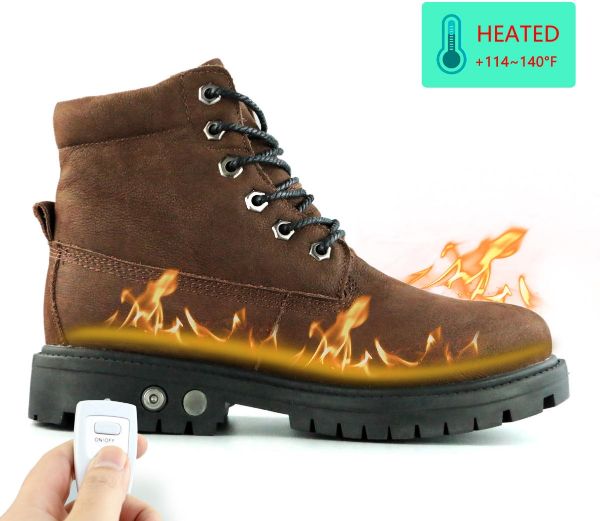As the temperature drops and winter approaches, keeping your feet warm becomes a top priority. Heated footwear has emerged as a popular solution to combat the cold. Two common options in the market are heated boots and heated socks.
In this article, we’ll compare the pros and cons of each to help you determine which option is best suited for your needs.
Heated Boots: Warmth and Protection in One Package
Heated boots are specifically designed with integrated heating elements to keep your entire foot warm. Here are some important points to consider:
Pros
- Comprehensive Warmth: Heated boots provide warmth to the entire foot, including the toes, soles, and ankles. They are ideal for individuals who struggle with chronically cold feet or those who spend long hours in cold environments.
- Weather Protection: Heated boots often come with insulation and water-resistant or waterproof features. They offer better protection against snow, slush, and wet conditions, making them suitable for outdoor activities like hiking, skiing, or snowboarding.
- Ease of Use: Heated boots typically have built-in controls for adjusting heat settings. Some models even offer battery-powered options, allowing you to customize the warmth and duration of heating according to your preferences.
Cons
- Bulk and Weight: Heated boots are generally bulkier and heavier than regular boots due to the integrated heating elements and batteries. This can limit mobility and may not be suitable for individuals seeking lightweight footwear.
- Limited Style Options: While heated boots come in various styles, the options may be more limited compared to regular boots. If style is an important factor for you, you might find fewer choices in the heated boot category.
Heated Socks: Flexibility and Versatility for Your Feet
Heated socks, on the other hand, provide heat primarily to the foot area and can be worn with any type of footwear. Let’s explore their pros and cons:
Pros
- Versatility: Heated socks can be worn with any pair of shoes or boots, allowing you to use your existing footwear without the need to invest in specific heated boots. This versatility makes heated socks a convenient option for daily use.
- Customizable Fit: Heated socks are available in different sizes and styles, allowing for a more personalized fit. This ensures comfort and the ability to layer them with regular socks for added warmth.
- Portability: Heated socks are lightweight and portable, making them easy to carry around during travel or outdoor activities. They are a practical choice for individuals who require warmth on the go.
Cons
- Limited Coverage: Unlike heated boots, heated socks primarily target the foot area. If you need additional warmth for your ankles or calves, heated socks may not provide the same level of coverage.
- Dependency on Footwear: Heated socks rely on the insulating properties of the shoes or boots you wear them with. If your footwear lacks sufficient insulation, the heat retention may be compromised.
- Battery Placement: Heated socks typically have a battery compartment, which can be bulky and slightly uncomfortable depending on the design. Proper placement and securing of the batteries are crucial to prevent discomfort during wear.
- Choosing Between Heated Boots and Heated Socks:
The decision between heated boots and heated socks depends on your specific needs and preferences. Consider the following factors: - Intended Use: Determine the primary purpose of your heated footwear. If you engage in outdoor activities or need maximum protection against cold and wet conditions, heated boots might be the better choice. For daily use and versatility, heated socks offer a more flexible option.
- Mobility and Weight: Consider the level of mobility and comfort you require. If you prioritize lightweight footwear or plan to move around extensively, heated socks offer greater freedom of movement compared to the bulkier heated boots.
- Existing Footwear: Assess your current shoe collection. If you have suitable insulated footwear and want the option to add heat when needed, heated socks can be a cost-effective solution. On the other hand, if you need dedicated winter footwear, heated boots provide a comprehensive solution.
- Budget: Budgetary constraints play a role in the decision-making process. Heated socks are generally more affordable than heated boots, making them a suitable option for those on a tighter budget.
Heated Boots vs. Heated Socks
| Heated Boots | Heated Socks |
|---|---|
| Comprehensive warmth for the entire foot | Provides heat primarily to the foot area |
| Weather protection (insulation, water-resistant or waterproof) | Versatile, can be worn with any footwear |
| Bulkier and heavier due to integrated heating elements and batteries | Lightweight and portable |
| May have limited style options | Available in various sizes and styles |
| Customizable fit, can be layered with regular socks | |
| Dependent on the insulation of the footwear worn with |
—
Both heated boots and heated socks offer effective solutions for keeping your feet warm during cold weather. Heated boots provide comprehensive warmth and weather protection, while heated socks offer versatility and the ability to use your existing footwear.
Consider your intended use, mobility needs, existing shoe collection, and budget when deciding between the two options. Ultimately, the right choice will depend on your individual preferences and specific requirements to ensure optimal comfort and warmth throughout the colder months.

For over 12 years, I have been testing and reviewing heating technologies that overcome cold weather conditions. In recent years, I have specialized in the heated apparel. I’ve made it my mission to educate people about heated clothing.
